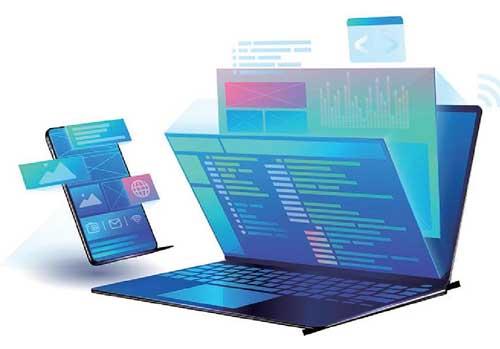Driving K-12 Innovation: 2021 TECH ENABLERS(Ⅱ) 译题 《基础教育创新驱动力报告——2021技术驱动篇》(二)
2021-07-20

Product by CoSN (Consortium for School Networking) 美國学校网络联合会
《基础教育创新驱动力报告》是继《地平线报告(基础教育版)》后推出的国际教育信息化发展的重要参考报告,报告发布方美国学校网络联合会(CoSN)为《地平线报告》发布方美国新媒体联盟的原有合作伙伴,致力于为基础教育及学前领域的教育技术从业者提供团队、知识和专业发展服务,助力创建和发展更有吸引力的学习环境。
Spotlighting Three Tech Enablers
Digital Collaboration Environments
Digital Collaboration Environments is a broad term that encompasses systems, tools, broadband connectivity, and practices for online collaboration—including synchronous and asynchronous communication tools. In light of the COVID-19 pandemic, these environments are more essential than ever as most interactions are digitally-mediated. For example, at Herning Gymnasium in Denmark, educators have integrated their learning management system (LMS), administrative systems, and collaborative documents platform to create a digital collaboration environment.
Recommendations from the Advisory Board
Humanize digital environments. Use technology in service of learning, fostering human connection, furthering collaboration, and developing empathy and social emotional learning in the digital environment.
Identify what has worked this year in terms of synchronous and asynchronous learning—including failures and successes—and build on those experiences. Involve students, teachers, administrators, families, and staff in creating the future of learning in their school system.
Select tools intentionally, prioritizing learning, student safety, equitable access, security, and data privacy. Its important to evaluate technologies—including free platforms— for compliance with the policies, standards, and laws relevant to your school system. Be intentional and attentive to how tools and systems that can connect to each other to form a cohesive environment and prioritize interoperability.
Untethered Broadband and Connectivity
Broadband connectivity is critical for many aspects of education and learning, including the use of digital collaboration environments. Untethered Internet access is also a key component of advancing Digital Equity, the top Hurdle for 2021. In Florida, St. Vincent Ferrer Catholic School provides loaner iPads and IT support to students as needed. The pandemic has not only accelerated the need for devices and hotspots but also the importance of information technology support as families and educators struggle to navigate this new way of learning.
Recommendations from the Advisory Board
Prioritize digital equity. Digital Equity includes three, interrelated components: digital foundations, conditions for learning, and meaningful learning opportunities. This nuanced hurdle encompasses more than just equitable access to quality digital technologies such as high-speed Internet and powerful computing devices both inside and outside of school.
Engage in efforts to ensure ubiquitous broadband Internet. Find out what universal broadband efforts are underway in your district, city, or state/country. Identify organizations engaged in this work. Partner with various levels of government, higher education institutions, private sector groups, industry, and community organizations to understand the challenges in your area and enact a community-wide connectivity strategy.
Empower educators, students, and families with the skills and knowledge to effectively use Internet-connected tools and devices. Invest in professional development and communities of practice around using Internet-connected technology for learning.
Blended Learning Tools
Blended Learning Tools include technologies, teaching and curriculum approaches, and norms that enable learning through a mix of in-person and virtual formats. These tools can transform learning, enabling greater flexibility, access, and personalization. Yet challenges of equity, data privacy, professional development, and digital literacy remain for many seeking to embrace blended learning tools.
Recommendations from the Advisory Board
Adopt blended learning tools, focusing on student learning. Start with the reasons for adopting blended learning tools. Select, implement, and support blended learning tools that enable student learning and align with pedagogy.
Provide flexible learning environments. Leverage blended learning tools to provide families and learners with options for how and where students learn. These technologies enable remote and hybrid learning, as well as in-person and physically distanced education. These tools can also support personalization and learner autonomy.
Support stakeholders in using technology. Provide training and resources to develop the technical skills and digital literacy of educators, families, and students. Support educators with time, processes, and expectations to set them up for success. Invest in human infrastructure, technical staff and services to support the implementation and ongoing use of selected digital collaboration tools.
Prioritize access, equity, and data privacy in the selection, implementation, and ongoing use of blended learning tools.
聚焦三大技术驱动因素
数字协作环境
数字协作环境是一个广泛的术语,包括系统、工具、宽带连接和在线协作实践,包含同步和异步通信工具。鉴于新冠肺炎疫情暴发,这些环境比以往任何时候都更为重要,因为大多数相互作用都是以数字为媒介的。例如,在丹麦的海宁体育馆,教育工作者已经整合了他们的学习管理系统、管理系统和协作文档平台,以创建一个数字协作环境。
咨询委员会建议
数字环境人性化。在数字环境中,利用技术为学习服务,培养人际关系,促进协作,培养同理心和社会情感学习。
明确今年在同步和异步学习(包括失败和成功的经验)方面的工作情况,并在这些经验的基础上继续努力。让学生、教师、管理人员、家庭和其他工作人员,参与到创建学校系统未来的学习与工作中来。
有目的性地选择工具,优先考虑学习、学生安全、公平访问、安全和数据隐私。评估技术(包括免费平台)对遵守与学校系统相关的政策、标准和法律非常重要。对工具和系统如何相互连接要有所留意,以形成一个有凝聚力的环境,并优先考虑互通性。
无限制的宽带和连接
宽带连接对教育和学习的许多方面都至关重要,包括数字协作环境的使用。不受限制的互联网访问也是推进数字公平的关键组成部分,这是2021年的最大挑战。在佛罗里达州,圣文森特费雷尔天主教学校提供iPad出借和信息技术支持服务,以满足学生需要。疫情不仅加速了对设备和热点的需求,而且在家庭和教育工作者努力驾驭这一新的学习方式之际,信息技术支持的重要性也日益凸显。
咨询委员会建议
优先考虑数字权益。数字公平包括三个相互关联的组成部分:数字基础、学习条件和有意义的学习经历。这一微妙的挑战不仅仅包括公平地获得高质量的数字技术,如高速互联网和校内外强大的计算设备。
努力确保宽带互联网无处不在。了解您所在地区、城市或国家(州)正在进行什么宽带普及服务。明确参与此工作的组织。与各级政府、高等教育机构、私营部门团体、工业和社区组织合作,了解您所在地区面临的挑战,并制定一项全社区的联通战略。
力争让教育工作者、学生和家庭具备有效使用互联网连接工具和设备的技能和知识。围绕使用互联网连接技术进行学习,投资专业发展和实践社区。
混合学习工具
混合学习工具包括技术、教学和课程方法,以及能够通过面对面和虚拟形式的混合进行学习的规范。这些工具可以改变学习,实现更大的灵活性、可访问性和个性化。然而,对于许多寻求采用混合学习工具的人来说,公平、数据隐私、专业发展和數字素养等方面的挑战仍然存在。
咨询委员会建议
采用混合学习工具,注重学生学习。从采用混合学习工具的原因开始,选择、实施和支持混合学习工具,使学生能够学习并与教学法保持一致。
提供灵活的学习环境。利用混合学习工具为家庭和学习者的学习方式和地点提供选择。这些技术支持远程和混合学习,即面对面教学和物理上的远程教育。这些工具还可以支持个性化和自主学习。
支持利益相关者使用技术。提供培训和资源,以培养教育工作者、家庭和学生的技术技能和数字素养。为教育工作者提供时间、流程和期望目标,以帮助他们取得成功。投资人力基础设施、技术人员和服务,以支持所选数字协作工具的实施和持续使用。
在选择、实施和持续使用混合学习工具时,优先考虑访问、公平和数据隐私等问题。
